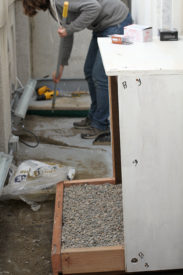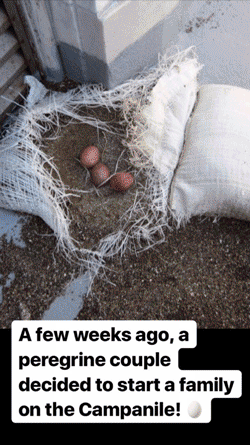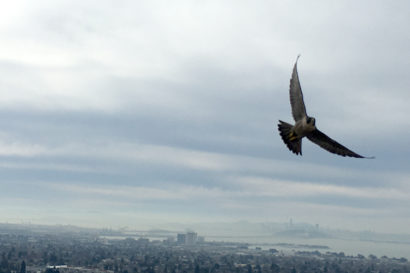Campanile peregrine falcons coupling up again, with a new nest box
The pair first made Berkeley's bell tower home last year and hatched two babies
January 31, 2018
For the second year in a row, two peregrine falcons are pairing up again atop the Campanile, but this year they’ll be nesting in style. Experts have installed a permanent nest box with sides, back and a roof that will protect the couple and their soon-to-be growing family from sun, wind and rain.
It’s a luxury suite compared to the temporary tray filled with gravel installed last year after the peregrines first made the bell tower their home.
The peregrines and their two chicks — named Fiat and Lux by the campus community in a Facebook survey — made national headlines last year, and inspired a group of volunteers to watch around the clock for the chicks’ first flight off of the 307-foot tower.
Now, the two adults birds, who have been living on the Campanile since last year, have again begun displaying “pair bonding behavior,” says Mary Malec, a volunteer raptor coordinator with the East Bay Regional Park District, who coordinated the volunteers on campus last year.

The peregrines’ new nest box was designed and built by Paul Romanak and Mary Malec. (Photo by Mary Malec)
“In the pair-bonding period, starting near the end of December, the male does all the hunting and brings food to the female,” says Malec. “They call to each other a lot and bow to each other, touching beaks. They will perch close together and fly together.” If all goes well, the female will lay eggs between mid-February and mid-March.
Once on the brink of extinction, peregrine falcons have made a remarkable comeback in the past few decades, and have begun moving from their natural cliff faces into urban areas, laying their eggs on skyscrapers and other tall buildings. The Campanile is prime real estate for peregrines, says Malec, with its great views and ample supply of pigeons to eat.
Peregrines mate for life (although when one dies the other will readily take a new mate) and most pairs in the area stick around during the winter, defending their territory from other birds looking to move in on their turf.

The campus asked its community for name suggestions for last year’s chicks born in May.
The nest box, made from redwood and marine-grade plywood, was installed by Malec and Doug Bell, wildlife program manager with the East Bay Regional Park District, with permits from state and federal regulatory agencies and with the cooperation of Golden Gate Raptor Observatory volunteers Sean Peterson and Lynn Schofield.
Although the nest area, on the west-facing side of the second balcony above the carillon bells, is closed and inaccessible to the public, Malec says there are good viewing spots on the east side of the Bancroft Library, the south side of Evans Hall and the back deck of McCone Hall. Campanile maintenance workers have been notified to stay off the nest level unless there is an emergency.
Malec says she and Bell will monitor the nest from the ground and don’t expect to go back up to the nest level until after eggs have been laid, any chicks have hatched and it’s time to band them.
Malec and Bell have been instrumental in creating a safer campus for the peregrines. After one of last year’s two chicks, Lux, struck a balcony window of Evans Hall and died, the team installed streamers along the balcony to try to prevent any similar accidents.
Learn more about peregrine falcons in this Q&A with Doug Bell.
Follow Berkeley News for updates on the Campanile’s resident peregrine falcon family.

